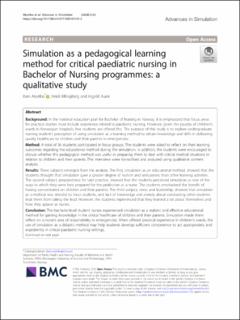| dc.contributor.author | Akselbo, Iben | |
| dc.contributor.author | Killingberg, Heidi | |
| dc.contributor.author | Aune, Ingvild | |
| dc.date.accessioned | 2021-01-08T07:57:12Z | |
| dc.date.available | 2021-01-08T07:57:12Z | |
| dc.date.created | 2020-09-17T22:09:48Z | |
| dc.date.issued | 2020 | |
| dc.identifier.issn | 2059-0628 | |
| dc.identifier.uri | https://hdl.handle.net/11250/2722113 | |
| dc.description.abstract | Background: In the national education plan for Bachelor of Nursing in Norway, it is emphasized that focus areas for practical studies must include experience related to paediatric nursing. However, given the paucity of children’s wards in Norwegian hospitals, few students are offered this. The purpose of this study is to explore undergraduate nursing student’s perception of using simulation as a learning method to obtain knowledge and skills in delivering quality healthcare to children and their parents in emergencies. Method: A total of 36 students participated in focus groups. The students were asked to reflect on their learning outcomes regarding the educational method during the simulation. In addition, the students were encouraged to discuss whether this pedagogical method was useful in preparing them to deal with critical medical situations in relation to children and their parents. The interviews were transcribed and analyzed using qualitative content analysis. Results: Three subjects emerged from the analysis. The first, simulation as an educational method, showed that the students thought that simulation gave a greater degree of realism and seriousness than other learning activities. The second subject, preparedness for later practice, showed that the students perceived simulation as one of the ways in which they were best prepared for the profession as a nurse. The students emphasized the benefit of having concentrated on children and their parents. The third subject, stress and leadership, showed that simulation as a method was stressful to most students, and lack of knowledge and anxiety about conducting other students kept them from taking the lead. However, the students experienced that they learned a lot about themselves and how they appear as nurses. Conclusion: The bachelor-level student nurses experienced simulation as a realistic and effective educational method for gaining knowledge in the critical healthcare of children and their parents. Simulation made them reflect on a nurse’s area of responsibility in emergencies. When offered practical experience in children’s wards, the use of simulation as a didactic method may help students develop sufficient competence to act appropriately and expediently in critical paediatric nursing settings. | en_US |
| dc.language.iso | eng | en_US |
| dc.publisher | BMC | en_US |
| dc.rights | Navngivelse 4.0 Internasjonal | * |
| dc.rights.uri | http://creativecommons.org/licenses/by/4.0/deed.no | * |
| dc.title | Simulation as a pedagogical learning method for critical paediatric nursing in Bachelor of Nursing programmes: a qualitative study | en_US |
| dc.type | Peer reviewed | en_US |
| dc.type | Journal article | en_US |
| dc.description.version | publishedVersion | en_US |
| dc.source.volume | 5 | en_US |
| dc.source.journal | Advances in Simulation | en_US |
| dc.source.issue | 24 | en_US |
| dc.identifier.doi | 10.1186/s41077-020-00140-2 | |
| dc.identifier.cristin | 1831018 | |
| dc.description.localcode | © The Author(s). 2020 Open Access This article is licensed under a Creative Commons Attribution 4.0 International License, which permits use, sharing, adaptation, distribution and reproduction in any medium or format, as long as you give appropriate credit to the original author(s) and the source, provide a link to the Creative Commons licence, and indicate if changes were made. The images or other third party material in this article are included in the article's Creative Commons licence, unless indicated otherwise in a credit line to the material. If material is not included in the article's Creative Commons licence and your intended use is not permitted by statutory regulation or exceeds the permitted use, you will need to obtain permission directly from the copyright holder. To view a copy of this licence, visit http://creativecommons.org/licenses/by/4.0/. The Creative Commons Public Domain Dedication waiver (http://creativecommons.org/publicdomain/zero/1.0/) applies to the data made available in this article, unless otherwise stated in a credit line to the data. | en_US |
| cristin.ispublished | true | |
| cristin.fulltext | original | |
| cristin.qualitycode | 1 | |

